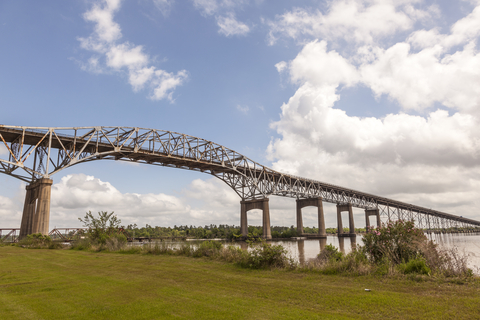Louisiana needs to replace the nearly 70-year-old I-10 Calcasieu River Bridge. It’s a project expected to cost billions of dollars that the state hasn’t set aside. Louisiana legislators are turning to a public-private partnership model with tolls to cover the bridge’s costs, which is good news for Louisiana drivers. Efforts must also be made to demonstrate to drivers, truckers, and the public why this model is vital to getting the critical infrastructure project done.
On Aug. 22,* the Louisiana Joint Transportation Committee, composed of legislators from both the Louisiana House and Senate transportation committees, held a hearing on the planned public-private partnership (P3) megaproject to replace the two-mile, four-lane I-10 bridge in Calcasieu Parish. The state has been looking to replace this bridge since the 1980s but lacks the funding. In 2017, a proposal to raise the state gas tax to help pay for this project failed to get to a vote in the legislature, so the Louisiana Department of Transportation and Development (LA DOTD) examined other project delivery options.
In December 2020, the Louisiana Joint Transportation Committee permitted the LA DOTD to pursue this project as a public-private partnership. This $2.1 billion P3 project is tentatively scheduled for final legislative approval later this month.
As lawmakers consider the proposal and before the project goes before the Joint Transportation Committee for approval, it’s essential to examine some of the main criticisms and concerns.
Following the LA DOTD project presentation, many state legislators wondered why this project was proposed as a toll concession public-private partnership. The answer is straightforward: Louisiana has no other realistic ways to fund a bridge of this magnitude at this time. The state hasn’t set aside the funding to prepare for this needed replacement, and there is no way to use existing fuel tax revenue to cover the total cost of the bridge reconstruction.
Additionally, the public-private partnership’s $2.1 billion cost is the capital cost required to build the bridge. Louisiana would be using a funding method that is similar to taking out a mortgage on a house rather than trying to pay for it all at once. This method has the added benefit of mitigating inflation risks because the private sector would provide the necessary capital up-front.
From a long-term financing perspective, a toll concession P3 is a more fiscally sound approach to operating and maintaining a bridge of this size than having the state try to go it alone.
If the state were to retain full stewardship of the bridge, in addition to the construction costs, all of the ongoing operational and maintenance costs would fall on Louisiana taxpayers. The current P3 proposal provides 50 years of guaranteed maintenance and operations of the bridge and requires the company to ensure the bridge is still in good condition at the end of the 50-year lease.
Legislators also asked explicitly why Louisiana could not build the bridge in a more traditional way. If the state used a more traditional delivery method (such as a design-bid-build, with the state’s transportation department responsible for all aspects of the project), there would be no assurance of on-time delivery or budget adherence.
For example, when the LA DOTD tried to repair the Hale Boggs Memorial Bridge through traditional means, the project suffered from delays and cost overruns. The cable replacement for the bridge took two years longer than anticipated, and the price—paid by taxpayers—rose from $30 million to $50 million.
While a public-private partnership does not eliminate all risks, one key P3 advantage is transferring risk from taxpayers to the private firm. In this case, the private concessionaire, Calcasieu Bridge Partners, would be responsible for covering any cost overruns in the project costs. In a P3, if costs surpass projections, the private firm bears the responsibility instead of Louisiana taxpayers. This protection is critical, especially given a 2003 Danish study that found that 90% of 258 examined transportation megaprojects faced cost overruns.
Additionally, if the company breaches its contract in some way, for example, by failing to keep the bridge open, it would be transferred back to the issuing authority—the Louisiana DOTD. Then, the state could decide whether to contract out to a different firm in a new P3 or retain stewardship for itself.
Following questions from the legislature at an August 2023 hearing, the floor opened to public testimony about the project. One of the speakers lamented the use of P3s for this project, citing the alleged tendency for bankruptcies of P3s concessionaires and concerns over what would happen to the bridge in such a situation.
As my Reason Foundation colleague Bob Poole wrote in Oct. 2019, when the original company contracted for the Indiana Toll Road P3 went bankrupt, taxpayers did not have to pay one additional dime for the project. Likewise, in the case of a default, tolls were not raised to compensate for P3 toll road bankruptcies in two cases in Texas and San Diego.
Another concern repeatedly raised by Louisiana Motor Trucking Association members was that a toll would constitute a double tax. But that’s a moot point; federal and state grants contribute only 38% (or $800 million) to this project. In effect, the bridge is funded by gas tax revenue and tolls. The bridge couldn’t be fully funded using existing tax revenue alone.
Still, the LA Department of Transportation heard these concerns and proposed a piece of sample legislation to ensure the toll isn’t onerous for trucking companies based in the local area. The sample bill says the owner of a commercial vehicle registered in Louisiana paying over $3,000 a year in toll costs, which was used as an example number and is subject to change, would be given a dollar-for-dollar business expense deduction for federal and state taxes. The proposal shows the LA DOTD wants to ensure it does not burden local trucking companies.
Overall, the proposed public-private partnership to replace the Calcasieu Bridge demonstrates a responsible and fiscally sound approach to addressing critical infrastructure needs in the state. The Louisiana transportation department has drawn on best practices from around the country in both the longevity of the contract and practices during the procurement phase to ensure competition between interested firms. Likewise, the LA DOTD is wisely choosing to lean on private sector expertise and financing to get the money the state needs for the bridge now rather than in the next decade while safeguarding the interests of Louisiana taxpayers.
*Correction: The date of the Aug. 22 hearing was originally reported as Aug. 25.

